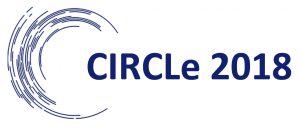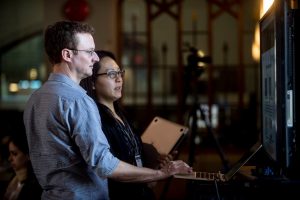Capturing and Reflecting the Learning Process through ePortfolios, 11:00 am to 12: 15 pm
To see all table discussion notes for this session, click here
Questions framing the presentations in Session 1:
- How can learning can be processed and represented using e-portfolios and online platforms?
- What do online platforms capture that other forms might not? What is problematic about using digital spaces for reflective practices?
- How can students use e-portfolios in more critical and reflexive ways?
- How should educators pedagogically distinguish between using e-portfolios as a tool for personal versus professional identity development?
- What are some best practices for documenting difficult, authentic, and complex learning experiences?
TABLE 4 DISCUSSION:
- Curriculum mapping → identify those common points where all students pass through, and then focus more on those.
- Totally different considerations once you shift to program level rather than course level
Q: When is a good time to get started with the ePortfolios, is it sometimes too early or too late? Is there a problem getting in early in 1st year with 18 year olds? Are their brains ready yet?
- The Bachelor of Media Studies program have students make their own portfolios in the application process; audience is the faculty… would be interested in thinking where would they take it for the public eye? Take them to a new level in first year.
- Disciplinary considerations? In Christine’s class are looking forward to opportunity to make connections and display — portfolios are part of the disciplinary culture; other disciplines: why are you asking me to do this?
- Students find valuable having the history of their learning but not necessarily making it public, especially early product
- Framing as a formative place to document your intellectual progress from each year. Creating and sustaining relevance in time and adapting to its changes during the duration of the program.
- Valuable to keep all the history of learning for audits and self-reflection in later phases.
- In first year: maybe not the time to have the assignment be a “present yourself as a whole person” but as a reflective starting point with expectation that this will change over time & opportunity in the future to reflect on what they’ve grown and developed (e.g., have a course later include an assignment where there is a reflection backward)
Networking ePortfolios: Integrating Technology with Learning and Connecting to the Real World, 1:30 pm to 2:45 pm
To see all table discussions for this session, click here
Questions framing the presentations in Session 2:
- How can educators encourage students to make connections between their academic work and life experiences?
- How might we better integrate e-portfolios in courses to improve student engagement?
- What kinds of projects get students to use the technology effectively, both during and after the course?
- What are the shared overlaps and differences between learning portfolios and career portfolios?
TABLE 4 DISCUSSION:
- At Capilano University, able to integrate ePortfolios across core courses because there’s a steering committee — easier because it was new
- Funding for peer mentors was from VP academics, now moved to CTE; 1 faculty member is lead with a course release (probably more sustainable than just X$ for cloud software)
- (new) Vantage vs in the (established) Geog Dept: Geog has 3/27 faculty involved which was useful
- Can’t dictate that everything has to be for every student → mandatory
- One other colleague is helpful for sustainability
- By third year may be too late to start
- It might be the B and C students who need ePortfolios the most, moreso than the A students
- If students get tripped up on the tech piece, miss out on the big picture
- ePortfolios used in Italian, 3rd year, to collect a set of resume, job search, etc in Italian
- https://web.hypothes.is/ including peer assessment using hypothes.is
- Instructor annotates readings, students comment on her annotations, then they come to class having engaged in dialogue already
- Nice example from GEOG: If already use service learning, use portfolio to capture experience reflections, include awareness of audience that includes the community partner (who we want to work with again!)
A potential process for a unit:
-
- We don’t want to mandate this for students or for faculty, but if enough faculty in a department are experimenting with non-traditional assignments, you could all sit down one day together, what are we all doing, and what lends itself to display in a portfolio? Then decide whether it would make sense to sync up in a portfolio, and how to do that.
Learning through Assessment and the Future of ePortfolios, 3:15 pm to 4:30 pm
To see all table discussion for this session, click here.
Questions framing the presentations in Session 3:
- What might institutional learning cultures (academic, universities, colleges) learn from e-portfolio cultures (professional careers, visual arts, performing arts) regarding approaches to assessment?
- What are best practices for creating ‘folio cultures’ for the future of education?
- What are the incentives, benefits and challenges for faculty, students and programs to use e-portfolios or personal web spaces?
- What can we do to get more value from these digital tools?
TABLE 4 DISCUSSION:
Points on Assessment from Tracy Penny Light:
- Context: where is the learning occurring?
- Stakeholders: who conducts the assessment? Who is interested in the results? How is assessment defined by all stakeholders?
- What is being assessed: Is learning the key focus? Who defines what constitutes evidence of learning?
- How is assessment happening: Is the ePortfolio the only source of evidence?
Comments from group discussion:
- Every form of an ePortfolio has the potential to alienate some users, not one solution fits all.
- In Education the platform was deployed without connection to classes, evaluation, or assignments.
- The Buy-in of faculty is harder in larger schools.

